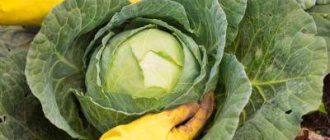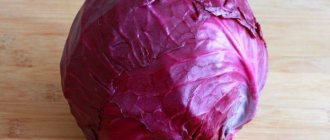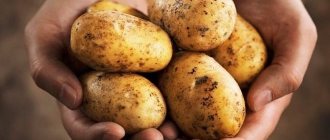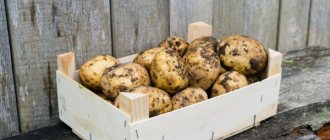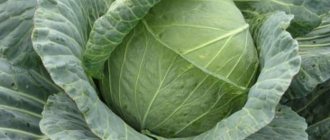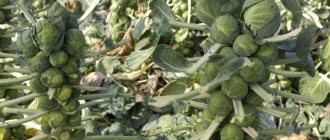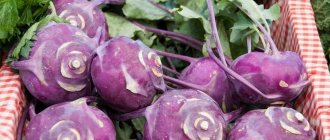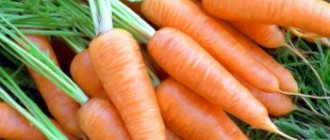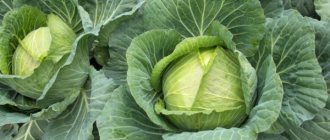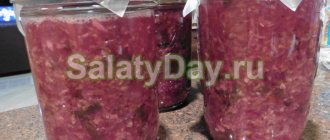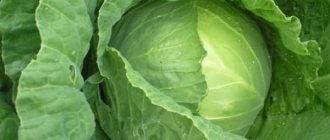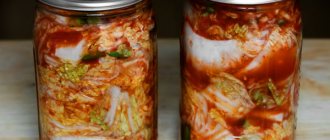Choosing a variety
Experienced gardeners grow cabbage of different varieties and different ripening periods on their plots.
Early varieties
The early-ripening vegetable has tender, soft leaves and a small amount of sugar. It is harvested 60-90 days after the seedlings emerge and is used mainly fresh, for summer salads. Early cabbage is not suitable for preparations.
Mid-season and late varieties
Heads of cabbage of mid-season varieties should “sit” in the garden for a longer period (100-145 days).
During this time, cabbage accumulates a large amount of vitamins, the leaves become juicy, dense and crispy. On a note!
The taste of cabbage depends not only on the characteristics of the variety, but also on proper care.
Such heads of cabbage are suitable for fresh consumption, pickling, and storage in the cellar. Due to its versatility, mid-season cabbage is very popular. Gardeners are also satisfied with the timing of the growing season, since the heads of cabbage have time to ripen even in regions with a harsh climate, where autumn comes early.
The ripening time for late cabbage is 145 days or longer; its heads are large, juicy, and suitable for pickling. The growing area is the south and central regions of Russia, since in Siberia, the Urals and the North-West such a vegetable does not always have time to reach full “condition”. Much depends on the characteristics of a particular variety, but in general, late-ripening varieties are grown specifically for winter storage, as well as pickling and fermentation.
How to choose cabbage for pickling. Which cabbage to choose
Previously, the cabbage harvest began to be harvested on Exaltation (September 27). On this day, cabbage and dishes made from it were always present on the table. Now we can say with great confidence that for pickling it is better to use late or mid-ripening white cabbage with strong elastic leaves, which means it is better to ferment cabbage in the fall. Cabbage heads should be dense, white when cut and have a thin leaf and a small stalk (1/3 of the height of the head). They must still accumulate at least 4% sugars by the time of harvesting.
The following varieties are suitable for fermentation: Slava, Garant, Countess, Moskovskaya late, Belorusskaya, Triumph, Flibustyev, Zimnyaya Gribovskaya, Podarok, Snow White.
Mid-late and late varieties and hybrids of white cabbage, which stand on the vine for a long time and only become prettier as a result, are best harvested after the first frost - the ripe heads caught in the frost become more sugary.
There is another interesting information about sauerkraut. Summer residents, this is for you! Sauerkraut is best made from... freshly harvested cabbage: between 24 and 48 hours after harvest. This is due to the fact that the population of lactic acid bacteria, which, according to the laws of nature, lives on the surface of the leaves, begins to die off during long-term storage. Namely, these bacteria are the main influencers in the fermentation process.
BY THE WAY: cabbage fermented with whole heads of cabbage will turn out tender and elastic, and the brine will be more tasty if you sprinkle a handful of crushed corn between the rows of heads of cabbage.
What does selection offer: the best varieties
The varietal assortment of cabbage is large, but summer residents most often focus on old varieties, being somewhat distrustful of new developments by breeders. The traditional choice of vegetables for pickling and pickling is the famous Slava, Podarok, Belorusskaya.
However, hybrids – domestic and foreign, mainly Dutch selection – are successfully salted and fermented. It’s difficult to argue about taste; every housewife has her own preferences. The new products are distinguished by high immunity, are little affected by diseases and pests, and are suitable for transportation - and these are clear advantages.
When choosing a variety, consider:
- ripening time;
- purpose;
- climatic conditions of the region;
- taste qualities;
- productivity.
The latest ones are put into cellars, but the heads of cabbage that ripen by the end of September or October are sent to tubs and barrels.
Varieties of mid-season cabbage
The varieties listed below are rightfully called ancient, used for pickling throughout the country.
Glory
The variety has been known since the first half of the 20th century; varieties have been bred, among which Slava 1305 is especially popular. The packages indicate that the variety is the best for pickling, and this is confirmed by enthusiastic reviews from gardeners of different generations. Slava is not stored for long; fresh heads of cabbage are used until November and December.
The outer “clothes” of the heads of cabbage are light green in color, the inner leaves are almost white. The shape is round, slightly flattened, weight is up to 5 kg, but on average forks are 3-3.5 kg.
Slava 1305 is a productive cabbage; full ripening occurs in the middle zone in September. At the end of the month, the heads of cabbage are cut and prepared for pickling.
Belarusian
This variety has long been known among gardeners and has been cultivated since the 40s of the last century. Ripens by the end of September (120-130 days), the heads of cabbage are dense and round. Weight is about three kilograms, the stalk is small.
The Belarusian requires good care and is prone to clubroot and other diseases. But the disadvantages are more than offset by the numerous advantages of the variety. Among them:
- excellent taste (in any form);
- high content of vitamins;
- good yield;
- shelf life 3-3.5 months.
They grow Belorusskaya with the marking 455, and there is also a late variety - the Belorusskaya 85 variety.
Present
The cabbage with the beautiful name Podarok, bred in the USSR in the early 60s, did not get lost among the numerous varieties. Valued for its juiciness and sweetness, pronounced taste. Used in salads, for preparing soups, main courses, good for pickling.
Gardeners praise the gift for its endurance and unpretentiousness in cultivation. The forks are round, dense, weighing 2-3 kg. The leaves have a waxy coating, giving the vegetable a grayish tint.
On a note! The advantage of the variety is the resistance of the heads of cabbage to cracking.
The gift shows high productivity in various regions of the Russian Federation, Ukraine, and Belarus.
Jubilee Semko
The heads of Yubileiny Semko cabbage grow up to 4 kg. The mid-season variety has been included in the State Register since 1993 and is recommended for all regions. The oval-shaped heads of cabbage have leaves covered with a strong waxy coating. The inner leaves are white.
The variety lies in the basement or cellar for up to 4-5 months, but is mainly used for pickling. The taste of pickled vegetables is excellent.
Krautman F1
The Dutch hybrid Krautman has become widespread throughout the regions of the Russian Federation. Valued for its high taste and resistance to adverse conditions.
The heads of cabbage are tight, dense, weighing 4-5 kg. Krautman is valued for its resistance to cracking and long storage (February-March). Considered one of the most delicious varieties for pickling and pickling
Amager 611
This variety has been known for more than half a century and is recommended for planting in all regions except the northernmost. This cabbage is characterized by increased cold resistance and is recommended for winter storage, during which its taste only improves. At first the leaves are bitter, but by spring the bitterness disappears and they become juicy. The heads of cabbage are dense, round or flat-convex. Plants are resistant to black rot and vascular bacteriosis.
| Productivity (kg per 1 sq.m.) | Head weight (kg) | Maturation (days) | Storage period (days) | Peculiarities |
| 5–6,5 | 2,5-4 | 115-140 | 160-190 | Plants do not tolerate heat well |
Varieties of mid-late and late cabbage
Cabbage with a growing season of more than 145-150 days is suitable for cultivation in the southern regions and central regions of the country.
Moscow late
The variety is grown everywhere, the heads of cabbage are well stored, tasty when pickled and preserved. Moscow late is distinguished by its productivity and ease of care.
Heads of cabbage – up to 7-8 kg, dense, with green-gray leaves. Valued for its resistance to cracking.
Amager 611
The variety has been grown since the 40-50s of the last century, and can rightfully be called a veteran of domestic selection. Despite the emergence of new cabbage hybrids, it is not losing ground and successfully competes with them. It is characterized by keeping quality, excellent taste, and resistance to low temperatures.
The forks grow up to 4 kg, the leaves have a waxy coating. Amager is suitable for winter storage (up to 5-7 months), suitable for transportation.
Kharkov winter
This cabbage is grown by private owners and farmers. In the State Register since 1976. The main advantages include:
- excellent taste;
- suitability for processing, fresh consumption, storage;
- resistance to prolonged drought.
The variety is little damaged by pests. The heads of cabbage take a long time to ripen; they are left on the ridges until the cold weather. Weight – 3-4.5 kg.
Stone head
A variety of Polish selection, in the State Register since 2006. The heads of cabbage are dense, with large bubbly leaves. The upper leaves are gray-green, the inner leaves are slightly yellowish.
The Stone Head variety is valued for its productivity and good taste. Ripens closer to October, is suitable for pickling, and can be stored for a long time (until April).
Valentina F1
The Valentina cabbage hybrid, familiar to gardeners in different regions of the Russian Federation, was included in the State Register in 2004. Forks are oval, slightly flattened, weight – 4-5 kg. There is a bluish waxy coating on the upper leaves; when cut, the head is snow-white.
The hybrid tolerates light frosts and ripens by the end of September.
Attention! Immediately after harvesting, a bitter taste is felt, which completely disappears when salted or after a couple of months of storage.
The hybrid is recommended for processing and can be stored for a long time. The taste only improves over time.
Geneva F1
The hybrid will delight you with dense, tight heads of cabbage weighing 3-4 kg. The shape is round, the leaves are dark green, snow-white inside.
Geneva F1 cabbage is recommended for storage (up to 9 months) and pickling. Ripens in September and is considered one of the earliest in the late-ripening group.
Merchant's wife
In 2011, the Kupchikha variety appeared in the State Register. Cabbage is highly rated by gardeners. Grown everywhere, shows excellent yields in the middle zone.
The heads of cabbage are flat-round in shape, weight – 2.8-3 kg. They store well, are resistant to rot, and do not lose their consumer properties.
Megaton F1
Medium-late ripening hybrids include Megaton (Holland). Since 1996, registered in the State Register of the Russian Federation. Shows record yields in different regions, despite long growing seasons, and is grown even in the North-West.
The heads of cabbage are half-covered, high density, juicy and crispy.
It is stored in the cellar for up to 2-3 months, but Megaton is mainly used for pickling and fermentation. Gardeners note the excellent taste of sauerkraut, comparing it with the traditional varieties Slava and Belorusskaya.
Valentina F1
This late-ripening hybrid produces large heads of high commercial quality that can be eaten throughout the winter. The heads of cabbage are medium in size, store well and retain their shape for a long period. The leaves are gray-green with a faint waxy coating on the edges. Cabbage has a pleasant taste, and is actively used for pickling and as an additive to various dishes. Plants are practically not susceptible to fusarium, and the yield of marketable products is 90%.
| Productivity (kg per 1 sq.m.) | Head weight (kg) | Maturation (days) | Storage period (days) | Peculiarities |
| 3,5-5 | 3,2-4 | 140-175 | 150-170 | The density of the leaves is quite high, so they need to be doused with boiling water before use. |
Modern selection proposals
Gardeners are trying new varieties and hybrids, including many “foreigners.”
Polar MS
This variety cannot be called a novelty; it was included in the State Register in 1997. Bred by Czech breeders, recommended for pickling.
The heads of cabbage reach a weight of 3 kg, the covering leaves are green, with a waxy coating, the inner ones are slightly yellowish.
The taste is excellent. The variety is disease resistant and transportable.
Atria F1
A hybrid from Holland, it is characterized by productivity and a large mass of heads of cabbage (7-10 kg). The forks are dense, rounded, the leaves are greenish-white. They do not crack in the garden, despite the long growing season.
Atria is mainly used for winter storage. The taste of the heads of cabbage becomes sweeter over time, and the hybrid is resistant to rot.
Turkiz
The late-ripening variety Türkiz (Germany) has good taste in pickling. Bred specifically for long-term storage (up to 8 months), resistant to rot and clubroot.
The forks are round, weigh 2.5-3 kg, and do not crack. The beds are harvested late, at the end of October, so Turkiz is recommended for the southern regions.
Salting miracle F1
The hybrid with the original name is grown in different climatic zones of Russia. Bred in Holland, recommended for storage and pickling.
The heads of cabbage are round, weighing up to 4 kg, with tightly adjacent leaves. Cabbage contains a large amount of sugars, the inner leaves are juicy and crispy.
Kvashenka
Cold-resistant cabbage variety offers agro. In terms of ripening time, it belongs to the group of mid-season species (130 days), and is highly resistant to unfavorable conditions.
Heads of cabbage are of medium size, weighing 3-4 kg. Inside there is a tight fit of leaves, there are no voids.
The variety is recommended (the name suggests) for pickling and pickling.
Fighter F1
A powerful hybrid will delight you with excellent harvests. Forks with a large number of upper leaves, weigh up to 4-5 kg, round in shape, high density. The surface of the leaves is gray-green, whitish when cut. Fighter F1 is a late hybrid; heads of cabbage are harvested already in October. Recommended for long-term storage. This cabbage was registered in the State Register of the Russian Federation in 2011.
Mara
The Mara variety is the pride of Belarusian breeders. Ripening time (160-170 days), belongs to the late-ripening group of cabbage. The heads weigh 3-4 kg, have a beautiful round shape.
The leaves are dark green, whitish inside. A strong waxy coating is visible on the outer leaves. The Mara variety is suitable for long-term storage, up to 6-8 months. Due to its high sugar content it is suitable for fermentation.
Aggressor F1
A favorite of gardeners, the hybrid Aggressor has been included in the State Register of the Russian Federation since 2003. Mid-late cabbage, grown in private and private farms.
The average weight of forks is 3 kg. The heads of cabbage are white inside, with a fine structure. Stem stalks of medium length. Main advantages:
- disease resistance;
- ease of care;
- juiciness;
- good taste.
When stored in the cellar, it is stored without loss of taste for up to 6-7 months. The hybrid is suitable for pickling and pickling.
Criterias of choice
Despite their apparent external identity, heads of cabbage even of varieties that are suitable for pickling according to their varietal characteristics may differ from each other. By what criteria can their quality be determined?
- Head size. Medium-sized heads of cabbage are easy to chop. But if you have the opportunity to buy a large head, then it is better to take it - large heads are more juicy and, accordingly, tasty.
- Leaf color. Only heads of cabbage with white leaves are suitable for pickling. Their color indicates that the level of natural sugars is already sufficient to ensure the desired fermentation process.
- Density. Elasticity and density are the main evaluation factors when choosing cabbage. They check it “by eye” or, if possible, cut the head of cabbage and see how correctly it is formed inside.
- Taste. Before shredding, be sure to taste a piece of the vegetable. The leaves should not be bitter, since the bitterness will not go away when salted. But if the “sample” turns out to be crispy, sweet and juicy in taste, then you can safely begin work.
Related article:
When to harvest cabbage from the garden? How to store cabbages in winter?
How to determine the suitability of cabbage for pickling by appearance
Having chosen the “right” varieties for fermentation, you need to provide them with proper care. The variety may be the best for pickling, but due to violations of agricultural technology, the heads of cabbage will turn out loose and tasteless.
Selecting heads of cabbage for pickling:
- the best weight of cabbage heads is 2-3 kg, “baby” forks will not work;
- when you press on the fork, it does not bend or lose its shape;
- when pressed, you can hear the creaking of the leaves, which is a sign of a high density of the head of cabbage;
- the outer leaves should be white or slightly greenish;
- The cabbage should taste sweet, without bitterness.
- stalk length – no more than 3-4 cm.
Early cabbage, specimens affected by pests, and those with rot are not suitable for processing. Some late varieties have a slightly bitter taste. This is cabbage for long-term storage; the bitterness goes away over time. But such varieties are not recommended for pickling and pickling.
Reviews from gardeners
Ekaterina, Perm region
I have always grown Slava, because I know that there is no better variety for pickling. But I’ve been trying Aggressor for the last two years, and I can’t praise it enough. The cabbage turns out crispy and tasty. We ferment in an enamel tank, keep it on the balcony until cold, then put it in jars and in the refrigerator.
Igor, Moscow region
At the dacha, in addition to the early ones, I plant Amager cabbage for storage, Belorusskaya and Valentina varieties for pickling. Amager is stored until March, no problems with heads of cabbage, but I don’t use it for pickling. I like Belorusskaya, it turns out juicy, moderately crispy, not rough. We have been growing Valentina cabbage for five years now, at first we chopped it only for winter salads, and now we have been fermenting it for the second year. It is advisable to ferment this variety later, closer to November, then it turns out tastier.
